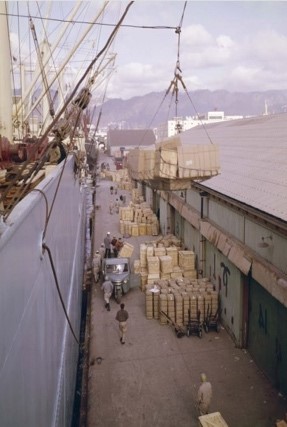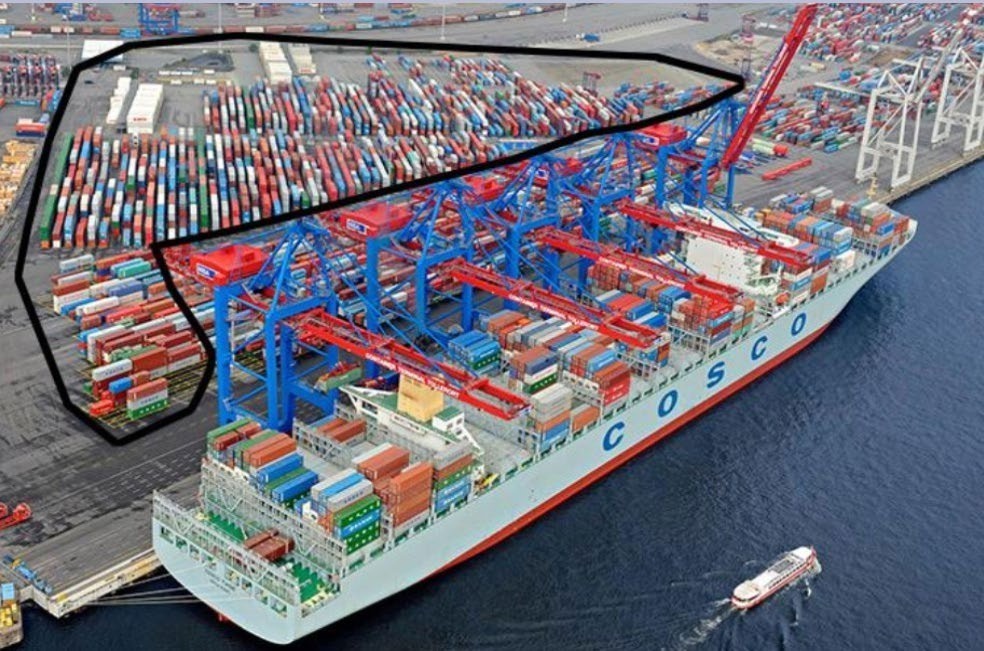Exactly 75 years have passed since Malcolm McLean invented the container, but international traders still haven't noticed!

Check out this video: https://bit.ly/472WI5v.
In the context of my professional activity, I notice, the use of techniques, documents and delivery terms that are not in line with the containerisation of goods. In particular, in the context of documentary credits it is rather frequent to detect a port routing of goods (with the evidence of the fields 44E Port of Loading/44F Port of discharge in the SWIFT MT700 message), the use of a maritime term of the Incoterms® (such as FOB, CFR or CIF) and the request for a "negotiable clean on board Bill of Lading” (hereafter, for convenience indicated as “BL”), perhaps with prohibited transhipment.
These indications are in stark contrast to the use of containers. Below we will try to identify the reasons for this:
Port routing vs. multimodal routing: The container, by its nature, includes a multimodal, non-port routing. A container, in fact, is unitized at an inland point, a point ahead of the port of departure of the goods and is delivered to an inland point, a point ahead of the port of destination of the goods. Port routing is specific to bulk goods, particularly commodities (coal, oil, iron ore, corn, grain, etc.) which, by their nature, are loaded on board ship at the port of departure and unloaded at the port of destination. Check for example this video: https://bit.ly/46aRxPr.

The widespread use of the maritime trade terms (in particular FOB, CFR and CIF) does not appear at all appropriate to the transport of goods in containers. It is no coincidence that the term 'container' does not appear in any of the Incoterms® rules where, instead, the term 'goods' appear. Also, when goods are containerised, it is not the goods that are loaded on board ship, but rather the container containing the goods! These maritime terms were used well before the introduction of containers! Before their introduction, in fact, goods were often delivered alongside the ship (FAS), or on-board ship (FOB), or on board ship but with freight paid by the seller (CFR) or on board ship but with insurance and freight paid by the seller (CIF). Until the 1950s, therefore, the legitimate use of these terms was widespread, in line with the logistics of the time.
With the introduction of containers, and thus with the evolution of multimodal transport, there is no longer a need to use maritime terms because the goods are delivered either at an earlier point than the port of departure (using the terms EXW, FCA, CPT, CIP) or at a later point than the port of destination (using the terms DAP, DPU, DDP). Containers cannot be 'delivered' along the ship's edge (FAS) or on board the ship (FOB/CFR/CIF) but are placed in the container yard of a port.

Therefore, it is quite incorrect to use the maritime trade terms for goods travelling in containers! Such terms, at present, are in fact almost exclusively intended only for traders buying and selling commodities such as iron ore, grain, coal or oil. In confirmation of this, it seems appropriate to point out the characteristics of the term CIF where it is the seller who is obliged to take out an insurance contract in favour of the buyer who bears the transport risk. This obligation does not appear at all appropriate for the sale of containerised goods, since, in that case, the seller-shipper and the buyer-consignee are known ab initio and it is therefore more logical that it is the buyer, holder of the risk of carriage, who insures the risk of perishment of the goods in line with his specific requirements in terms of choice of company, currency of indemnity, percentage of cover, spatial cover, conditions, risks to be insured, etc. The trade term CIF, in fact, is designed for traders buying and selling commodities where the final consignee of the goods is not always known (such types of goods being subject to resale during the voyage) ab origine. In the case of CIF sales, therefore, the seller is obliged to insure the goods - not surprisingly because of the peculiar risks involved in commodities trading - in favour of the unknown final buyer of the goods.
“Negotiable" clean on board Bill of Lading: The consignee box of many bills of lading reads "This bill of lading is not negotiable unless marked "To Order" or "To Order of...” Bills of lading therefore can be "straight" or "negotiable" and a high percentage of documentary credits require a "negotiable" bill of lading. "Negotiable"; to allow the buyer to resell the goods during the journey. This appears to be a requirement for commodity traders and certainly not for traders buying and selling goods in containers! It should also be noted that UCP 600 article 27 states the following: "The word "clean" need not appear on a transport document, even if a credit has a requirement for that transport document to be "clean on board". The reasons for this go back to the time when it was necessary to load the goods "clean on board" and it could be ascertained that the goods were perfectly loaded on board the ship. However, in the case of containerised goods, the carrier has no way of ascertaining the condition of the goods and therefore legitimately refuses to include the indication "Clean" in the bill of lading and this is appropriately codified in the UCP 600. The B/L also "acts as a document of title to the goods". In fact, many bills of lading are usually issued in 3 originals and read as follows:
"One of these Original Bills of Lading must be surrendered duly endorsed in exchange for the goods. In witness whereof the Original Bills of Lading all of this tenor and date have been signed in the number stated below, one of which being accomplished the other(s) to be void."
This indication seems inadequate for the buying and selling of goods in containers which, having arrived at the port of destination, "must" continue its journey to its final destination. Currently, around the world, there are ships capable of carrying even 24,000 containers. Some of these ships are capable of travelling at such speeds that they can cover the China-California route in 4 days! Therefore, it is certainly unthinkable for companies or port authorities to deliver the container to the consignee upon presentation of the 'duly endorsed' bill of lading. Not surprisingly, some carriers tend, subject to certain conditions, to deliver the container to the consignee without necessarily presenting the original bill of lading with clauses to the following effect: "Where the bill of lading is non-negotiable the Carrier may give delivery of the Goods to the named consignee upon reasonable proof of identity and without requiring surrender of an original bill of lading. Where the bill of lading is negotiable the Merchant is obliged to surrender one original, duly endorsed, in exchange for the Goods".
Transhipment not allowed: Transhipment is not allowed in many documentary credits. (According to UCP 600, "transhipment means unloading from one vessel and reloading to another vessel during the carriage from the port of loading to the port of discharge stated in the credit"). This may make sense in the context of commodities trade where the buyer legitimately intends to prohibit transhipment operations that could prove risky for certain types of bulk goods. Such an indication, on the other hand, is not appropriate for container ships since transhipment operations from one ship to another of containers, which are frequent and physiological, do not appear particularly risky. And it is no coincidence that the UCP 600 states in sub-article 20 (c)(ii) (which applies when the claim shows port routing) the following: "A bill of lading indicating that transhipment will or may take place is acceptable, even if the credit prohibits transhipment, if the goods have been shipped in a container, trailer or LASH barge as evidenced by the bill of lading."
In the light of this, it seems appropriate to structure documentary credits in line with the factual and current logic of the world of transport, highlighting multimodal routings by completing the fields “44A place of receipt” and “44B place of final destination” in the SWIFT MT700; using the relevant multimodal delivery terms FCA instead of FAS or FOB (not merely substituting FAS or the more used FOB with FCA port of departure, but FCA where the goods are delivered to the carrier/freight forwarder), CPT instead of CFR term, CIP instead of CIF term (by their nature, the D terms do not fit well with payments under documentary credits); allowing transshipments and using a multimodal (or combined) transport document (that may act as a document of title), also allowing the legitimate consignee to collect the container at destination without necessarily presenting the transport document. In the writer's opinion, the use of 'multimodal' techniques, tools, documents, and methodologies could only create value for all operators involved, with the consequent reduction of risks inherent in international trade. However, it appears to be of considerable importance to note that the use of transport documents "that does not act as a document of title to the goods" (such as the Non-negotiable Seaway bill or the multimodal transport document with internal destination), would not allow the sellers-beneficiaries of documentary credits to exercise control over the goods, taking into account, however, that the control of the goods appears to be an empirical solution to the difficulty of preparing compliant documents in the context of documentary credits and to the not always scientific approach of the bank operators involved in the examination of the documents.
A second-best solution could be found in the use of the Non-negotiable Seaway bill in the name of the issuing bank. With this solution, in any case not in line with the factual and current logic of the world of transport, the beneficiary would still obtain control of the goods at destination with considerably less risk than with the use of the bill of lading. The Non-negotiable Seaway bill, in fact, unlike the Bill of Lading, "does not act as a document of title to the goods", can easily be reissued in the event of loss of the document. Furthermore, the difficulties related to the delivery of original documents to the issuing bank experienced in the Covid-19 era would be avoided.
For the sake of completeness, it is noted that the well-known peculiarities of the bill of lading to be a "negotiable" document of transport and a "document of title to the goods" are, in fact, only theoretical.
Hardly, in fact, a buyer of containerized goods endorses the Bill of Lading in order to resell the goods and it is not by chance that carriers report, in the bills of lading, indications such as "Particulars furnished by the shipper - Not checked by carrier - Carrier non responsible" or "STC (said to contain shipper stow, load and count) or similar indications.
In conclusion, it can be said that a scientific approach in understanding the techniques and logic of the technical processes of an international trade is increasingly appropriate in order to create value by reducing the risks of an international trade.